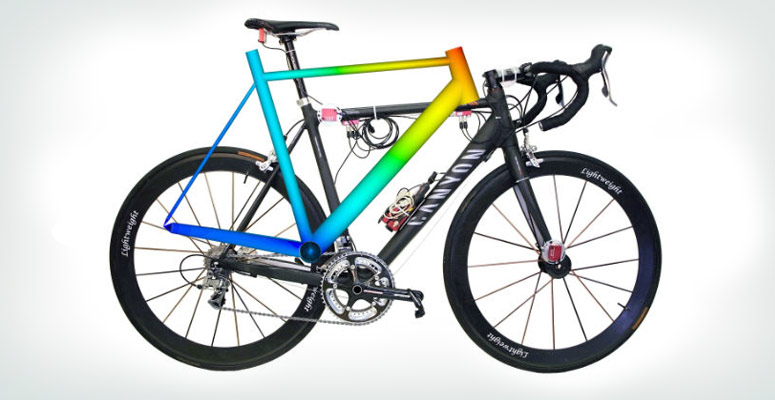Fibre composites in sport

Athletes and coaches are enthusiastic, top athletes achieve top performances and Carbon also celebrates success in popular sports across the board. For sports, carbon seems to be just the right material to help athletes get the best out of themselves and their sports equipment.
Carbon is light and yet highly resilient, rigid and elastic at the same time, it can be shaped almost freely, it does not rust and can absorb or pass on large amounts of energy. Carbon is a fibre-plastic composite material (FRP) or carbon fibre reinforced plastic (CFRP). Different mechanical, thermal and physical properties of the end product can be selected depending on the added fibre, plastic matrix and the specific combination of the two basic components. The combination with other materials such as wood, aluminium, steel, etc. in so-called composites or hybrid composites further extends the spectrum. This means that every piece of sports equipment made of and with carbon can be configured to suit the specific sport and athlete.
Material made to measure
This makes carbon in sports the ideal material for sports equipment and accessories. Athletes and engineers have known this for quite some time and follow every innovation in the field closely. One of the scientific pioneers was the Berlin Institute for Research and Development of Sports Equipment (FES) – a member of Composites United e.V. (CU). The experts there have been working on the subject since 1976, when carbon first indicated its enormous potential in the GDR era. The then dominant research field of boat building, especially for rowing, canoeing and sailing, has remained as topical and exciting as ever since then. At the beginning of the 1980s, cycling was added, first with disc wheels, then also with complete frames. More recent research focuses on winter sports equipment such as skis, skeleton sleds, bobsleds, etc.
In general, the FES experts are researching the interaction between man and material, in the case of carbon in all sports where “the regulations allow it”, summarizes Dipl.-Ing. Harald Schaale. When it comes to carbon, the expert is almost enthusiastic: “The mass-to-stiffness ratio is simply unbeatable. Carbon is a material made to measure!”
Sports equipment made of and with carbon
The same advantages that make the extremely light yet strong material so attractive for the automotive industry, aerospace, energy and medical sectors, as well as the construction industry, make carbon such an advantage in sports. The lightweight material supports active people in almost all sports in their never-ending quest to improve and ultimately surpass themselves. At the same time, carbon in its triumphal procession through the world of sport by no means displaces traditional materials such as wood or steel. Rather, its precursors often enter into syntheses that are simply the better alternative, from tennis or golf clubs, to arrows and spears, to boat hulls and racing components – to the benefit of athletes and the sport.
Mass sports
The success story of carbon in sport undoubtedly began with the professional. Wherever the optimum is always being researched and sought, where the better material can bring decisive milliseconds and – this is also the truth – where money is usually not the decisive factor, in other words in competitive and competitive sports, carbon has been a constant for decades. What’s more, thanks to its versatility and the resourcefulness of its engineers, the possible uses for carbon are multiplying in ever shorter intervals, both quantitatively and qualitatively.
Most of the sports equipment and accessories made of carbon mentioned below have already found their way into popular sports. Not only ambitious amateur athletes swear by rackets, paddles, runners, paddings, joints made of super-light carbon composites. This also applies beyond mass sports. For billiard players, for example, there are cue tips as well as whole cues made of carbon, speed fans whizz through the city on carbon skateboards, which are by no means limited to a subtle black, or race down slopes on longer downhill speedboards, jugglers play their colourful game with diabolos and handsticks made of carbon, and weekend excursionists paddle leisurely on the Altmühl in canoes made of carbon fibre-reinforced plastic.
Not to mention carbon bikes, which are in great demand among young and old, either ‘pure’ or in the e-bike version. This field is already so broad that additional features such as sustainability can be the deciding factor in a purchase decision. This was clearly visible in the fully recyclable carbon bike nam:e, which was developed by experts from the Institute for Lightweight Construction and Plastics Technology (ILK) at the TU Dresden together with project partners from industry and presented for the first time at the Euro-Bike 2015.
Right from the start, the Nordic Walking poles were and are designed for mass sports and are made of carbon, which is as light as it is suitable for off-road use and heavy duty. A pair of 120 centimetre long poles, for example, weighs around 400 grams. Both together, mind you. One manufacturer sums it up for his new Nordic Walking folding pole: “100% pure carbon and titanium sleeves between the segments ensure absolute lightness with maximum stability. Whether for Nordic Walking or trail running …”
The important role of carbon in fishing is also worth at least a laudatory mention. In this area, carbon fishing rods, which are as light as they are rigid and robust, are now ‘state of the art’.
Golf
Rarely do beginners choose golf clubs on the green or with carbon, because they play comparatively hard and do not forgive gross errors. But if you know what you are doing, you are well served with a carbon-composites hybrid golf club. With a driver, the club crown is usually made of carbon, which gives the sole more weight. A carbon crown combined with a titanium clubface and sole, for example, is designed for a high launch angle (13 degrees loft) and low spin with more length. But there are also precision milled putters made of a one-piece carbon stainless steel block with the best stroke consistency.
The irons, especially those for women, often have a shaft made of CFRP, usually referred to as ‘graphite’ in golf. However, the advantages of the flexible, precise and shock-absorbing graphite shafts have not gone unnoticed by men either – a strong competition to the steel shafts traditionally used by male golfers.
Athletics
There is almost no discipline in athletics that does not revolutionize the composite material, which is still relatively new here. A competition discus, for example, weighs one to two kilograms; if it consists partly of carbon, 85 percent of the weight is shifted in the steel ring. In technical terms, the comparatively light and very stiff inner carbon shell ensures high peripheral mass and smooth flight. In other words: The carbon disc turns very well and can therefore be thrown very far.
The combination of lightness and stability also makes javelins with carbon shafts very popular with athletes. Usually such a competition javelin weighs 600 to 800 grams. With different tips, mostly made of steel, and with almost any stiffness depending on the added fibre, there are javelins suitable for every occasion, depending on the wind direction, the desired degree of hardness (flex) and the physical and technical ability of the caster.
The same applies in principle to high jump javelins. Carbon jumping poles are light, thin and therefore easy to handle with optimal elasticity. This makes them the first choice especially for technically experienced athletes. A modern CFRP vaulting pole measures about five centimeters in diameter at a length of 3.75 meters and is hollow inside. Pole vaulter Lisa Ryzih jumped her personal best of 4.72 meters in 2015 in the gym with a carbon fiberglass pole.
Carbon plays a special role in the jumping and running disciplines. The leg-disabled track and field athletes Oscar Pistorius and Markus Rehm achieved top sporting performances with their carbon fibre leg prostheses and thus made their aids and sports equipment (see below) known throughout the world.
Motor sports
The same advantages that make the extraordinarily light, corrosion-resistant and virtually infinitely malleable carbon so attractive for the automotive industry are also in demand in car and motorcycle racing. In Formula 1, for example, high-performance brakes made of ceramic matric composites are commonplace. They are extremely light and particularly powerful thanks to their above-average friction coefficient of 0.6. A Formula 1 car can brake from over 300 km/h to less than 100 km/h within 90 meters. In the motorsport sector, brakes are made from carbon/carbon (C/C), i.e. carbon fiber-reinforced carbon. However, this technology is not suitable for production cars, where carbon fiber-reinforced silicon carbide (C/SiC) materials are used.
The Nascar races are a bit more down-to-earth, but here too C/SiC-brakes are indispensable. For the first time at the 2013 Stockcar race in Daytona, USA, several manufacturers competed with carbon-improved, i.e. lighter Generation 6 vehicles. Today, CFRP and composite parts from the body, spoilers and various covers to the steering wheel or cooler are commonplace. Incidentally, a Kevlar cover prevents splintering at critical points in the event of an accident, thus ensuring maximum safety.
Needless to say that motorcycles in racing are not lagging behind in terms of carbon either. Whether Superbike or MotoGP, there are numerous high-quality carbon components available for almost every brand and every machine. Exhaust heat shields, chain guards, mudguards, seals of all kinds, lamp housings, air boxes or wind shields are just a few of them.
Racket/bat or ball sports
Carbon rackets are undoubtedly part of today’s product range in hockey, tennis, badminton and squash. Their popularity can be easily explained with numbers, a robust and reliable aluminium-carbon badminton racket weighs 90 grams without strings and even a similar squash all-round racket of the same type, which weighs twice as much (185 grams), is hardly significant.
In table tennis, carbon forms an attractive combination with wood. One manufacturer’s Carbowood technology with a carbon fibre-reinforced blade provides “a larger sweet spot, less vibration and increased accuracy”, attractive for both professional and amateur players.
Even those who are enthusiastic about sports less known in Europe, such as lacrosse, appreciate carbon as a racket material. Carbon in cricket is a case in itself. In 2005, a manufacturer reinforced the inside of the original tube-wicker bat with a carbon polymer. However, the International Cricket Council (ICC) banned this new type of bat shortly afterwards as ‘unfair’, because on the one hand it enabled more powerful shots, but on the other hand it was not available to all players worldwide. A decision that was discussed quite controversially in the cricket world. Also ‘cashed in’ was a light carbon cricket bat handle, which was also introduced in 2005. In order to prevent the cricket ball from being hit too far, a grip may now only be made of tubing and a maximum of ten percent ‘foreign material’ such as carbon.
Cycling
Cycling is the ideal application for lightweight carbon. Mountain bikers, road and indoor cyclists alike appreciate the light and lightweight bikes weighing only a few kilograms. In off-road conditions, the weight advantage of MTBs with carbon frames and equipment is convincing, at the latest on carrying tracks. And if you need to be able to rely on your equipment one hundred percent when riding downhill over rough and smooth, you will gladly choose a reliable carbon MTB handlebar. The same applies on the road and in the hall, even if under different conditions in different surroundings. A modern carbon racing bike weighs under seven kilograms, and the tendency is still falling. Professional cyclists such as the runner-up in the European Championship and Olympic participant Ricarda Lisk or the triathlete Philipp Mock swear by this lightweight, noble material.
A comforting tip for recreational athletes: Even if it can’t be an entire carbon frame, almost every component of a bike is also available in precious black carbon: Handlebars, stem, fork, seat post, saddle, rims, attachments (bottle cage, etc.)… – there is (almost) nothing on a bike that is not available in carbon.
Shooting sport
Since the late 1980s, early 1990s carbon has been known as a material for arrow shafts among archers. Since then, it has practically replaced aluminium or even wooden arrows due to its excellent flight characteristics, at least in the competitive sport of recurve and compound archers. Carbon stabilizers and visors also proved themselves in practice early on. With these good experiences in the background, grip shells and center pieces made of carbon, and later also composite limbs, had a comparatively easy time establishing themselves in archery.
Light, precisely machined carbon parts are also available for the sports equipment of rifle shooters. For example, a cheek piece support made of carbon in a cheek piece feels pleasantly soft and rather warm when placed on the cheek piece. Shooters report that this makes it much easier for them to keep their head in exactly the same position, which increases the hit rate.
Water sports
A wide field is the use of carbon in water sports. A lot of space has always been devoted to boat building. A shell made of carbon fibre reinforced plastic makes canoes, kayaks, rowing and sailing boats light and manoeuvrable. Here the course is clearly set on CFRP, the next steps are already in the pipeline. For example, Dr. Gary Leeke, Professor of Chemical Engineering at the British University of Birmingham, and his team have developed a CFRP two-person kayak with walls only two to three millimeters thick made of recycled carbon fibers obtained from waste from the space industry. The innovative boat passed its baptism of fire at the venerable 125-mile Devices to Westminster Canoe Race (DWCR) on the Thames at Easter 2016.
Also predestined for the carbon version are oars and paddles, the frames for kitesurfing and, very large, windsurfing and surfing boards.
The use of carbon in swimming may be a little surprising. But the latest generation of swimwear and powersuits for competitions advertises with a one percent carbon content, which promises full elasticity and thus freedom of movement with functional posture support at the same time.
Winter sports
Carbon of course, that’s obvious if you are looking for light, elastic and robust material for skis. Carbon-reinforced skis or skis with carbon inlays have proven themselves in downhill skiing, speed carving and in the Nordic disciplines. Even on hard pistes they ensure smooth running and control, but are still sporty and sleek. Alongside aluminium carbon and carbon composite, the materials of choice for ski poles are also aluminium carbon and carbon composite.
Talking of sleek: sleds and toboggans made of and with carbon go downhill and downhill incredibly well on the piste and in the track. They are light and fast, advantages that even bobsleigh and skeleton riders naturally don’t want to miss.
Snowboards are also increasingly being made of carbon composites and are therefore lighter, which makes them more comfortable to ride on the slope as well as to wear.
Finally, ice hockey and curling may be considered the stepchildren of classic winter sports, but when it comes to carbon, they are at the forefront with CFRP sticks and poles. And last but not least, skates, whether they are intended for ice hockey, speed skating or figure skating, are becoming more and more popular with skaters, since they are especially firmly anchored under the shoes and glide very well.
Disabled sports
A broad public has come to regard carbon as the “miracle material” of the future, also in sports, at the latest since the triumphs of the so-called Blade Runner Oscar Pistorius until 2013 or, more recently, of Markus Rehm. Both transtibial amputees run and jump away from their competitors in competitions with non-disabled athletes as well – with carbon prostheses modeled on the hind legs of cheetahs. Markus Rehm, for example, became general German champion in the long jump on July 26, 2014 with 8.24 meters. He already held the Paralympics world record in this discipline before that.
However, he and other prosthetic jumpers were not admitted to the later European Championships, as the German Athletics Association (DLV) announced in a fundamental decision. According to biomechanical evaluations, doubts about the comparability of jumps with and without carbon prostheses are too great. Admittedly, this contradicts earlier decisions of the IAAF and the International Court of Justice for Sport (CAS) in Lausanne, which had allowed the joint competition.
On the other hand, the use of carbon aids in purely disabled sports is undisputed. The North America department of a major European car manufacturer, for example, developed a spectacular racing wheelchair made of carbon especially for the US Paralympics team in Rio de Janeiro in 2016. Wheelchair athlete and multiple Paralympics gold medalist Josh George considers it to be “the coolest looking thing I’ve ever seen.
In Germany, too, work is being done on top sports wheelchairs made of carbon. Dr.-Ing. Marc Siebert from the Institute for Materials Engineering at the University of Kassel, for example, can draw on many years of experience in the construction of light racing bikes and hand bikes, i.e. sports wheelchairs with crank drive. Building on this, he and his team developed an extra-light wheelchair made of carbon. Its low weight of 5.9 kilograms (instead of the ten to 15 kilograms of a conventional wheelchair) makes it easy to handle in sports and everyday life. A broadly effective, practical approach, which was awarded second prize in the Promotion Nordhessen start-up competition.
Accessories
The possible uses of carbon in the wider field of actual sport are many and varied, just think of functional and protective clothing such as protectors, helmets, bodies, shells, cycling, enduro or ski boots, as well as accessories ranging from storage containers to spill-proof drink cups. The lightness, stability and almost unlimited formability of the material always play a decisive role.
For example, a custom-fitted carbon face mask worn by Hertha BSC striker Vedad Ibišević at a Bundesliga football match, when he ran up and played for his team despite a recently fractured maxillary sinus. For many spectators in the stadium and on the screens, this was certainly a martial sight, but also a memorable one, which until then was more familiar from similar hockey masks. By the way, this protection category also includes all ski, cycling and other sports helmets as well as shin, knee, arm and arm protectors of all kinds, whether for footballers, skiers or archers.
In general, the application possibilities of carbon fiber reinforced plastics in the sports environment seem endless. Foldable trolleys weighing 3.5 kilograms are available for golfers, for example, carbon spacers keep a distance, for example between weights or on the bicycle stem, today’s rifle and pistol shooters naturally work with rifle tripods and cleaning sticks made of CFRP, in equestrian sports, carbon gaiters and jumping bells protect sensitive horse legs and hooves, springboards in carbon-fibrid sandwich construction support the dynamic jumps of track and field athletes and high jumpers, and carbon even holds its own in the production of swimming pools. In fact a “material made to measure”, as meanwhile not only experts know.


















